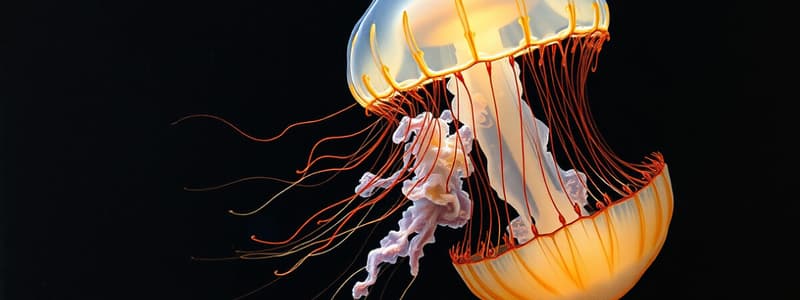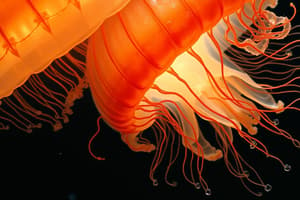Podcast
Questions and Answers
What type of organisms are Ctenophores?
What type of organisms are Ctenophores?
- Comb jellies (correct)
- Fish
- Mollusks
- Crustaceans
What is the structure that aids in swimming in Ctenophores called?
What is the structure that aids in swimming in Ctenophores called?
comb paddle
Which of the following is a characteristic of Ctenophores?
Which of the following is a characteristic of Ctenophores?
- Biradial symmetry (correct)
- Triploblastic organization
- No nervous system
- Presence of nematocysts
What are colloblasts?
What are colloblasts?
What role does the statolith play in Ctenophores?
What role does the statolith play in Ctenophores?
What is bioluminescence?
What is bioluminescence?
What distinguishes Class Tenaculata within the Ctenophores?
What distinguishes Class Tenaculata within the Ctenophores?
What distinguishes Class Nuda within the Ctenophores?
What distinguishes Class Nuda within the Ctenophores?
What type of organization do Ctenophores exhibit?
What type of organization do Ctenophores exhibit?
Describe cydippid larva.
Describe cydippid larva.
Flashcards are hidden until you start studying
Study Notes
Phylum Ctenophora Overview
- Comprises comb jellies, organisms distinct from jellyfish, featuring a simpler life cycle.
- Lacks nematocysts (stinging cells); captures prey using sticky cells on two long tentacles.
- Locomotion results from the beating of eight rows of cilia known as combs.
Characteristics
- Organismic structure is either diploblastic or potentially triploblastic, showing tissue-level organization.
- Displays biradial symmetry.
- Contains a gelatinous mesoglea situated between epidermal and gastrodermal tissues.
- True muscle cells arise within the mesoglea, enabling movement.
- Possesses a gastrovascular cavity for digestion.
- Nervous system operates as a nerve net, facilitating networked communication.
- Features adhesive structures called colloblasts for prey capture.
- Movement is facilitated by eight ciliary bands, termed comb rows.
Unique Structures
- Comb Paddle: Made up of eight rows of cilia that assist in swimming; each paddle resembles a comb and contains thousands of cilia.
- Statolith or Apical Sense Organ: A calcareous particle found within statocysts; responsible for balance and orientation by stimulating sensory receptors in response to gravity.
- Colloblast: A specialized cell located on ctenophore tentacles; discharges a sticky adhesive thread to trap prey.
Life Cycle Stages
- Cydippid Larva: This larval stage is characterized as free-swimming with an ovoid or spherical shape; represents an early developmental form of ctenophores.
Classes of Ctenophores
- Class Tenaculata: Encompasses ctenophores that have tentacles.
- Class Nuda: Comprises ctenophores that lack tentacles, showcasing a different structural adaptation.
Bioluminescence
- Exhibits bioluminescence, allowing these organisms to produce light through chemical reactions, contributing to their allure in marine environments.
Studying That Suits You
Use AI to generate personalized quizzes and flashcards to suit your learning preferences.




